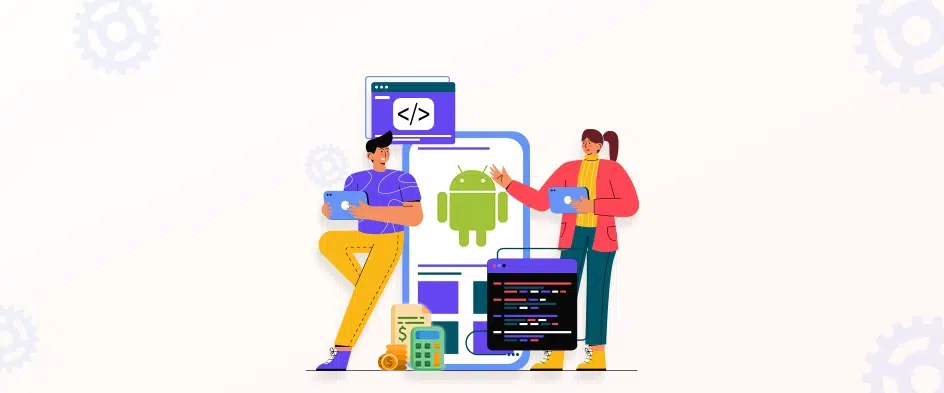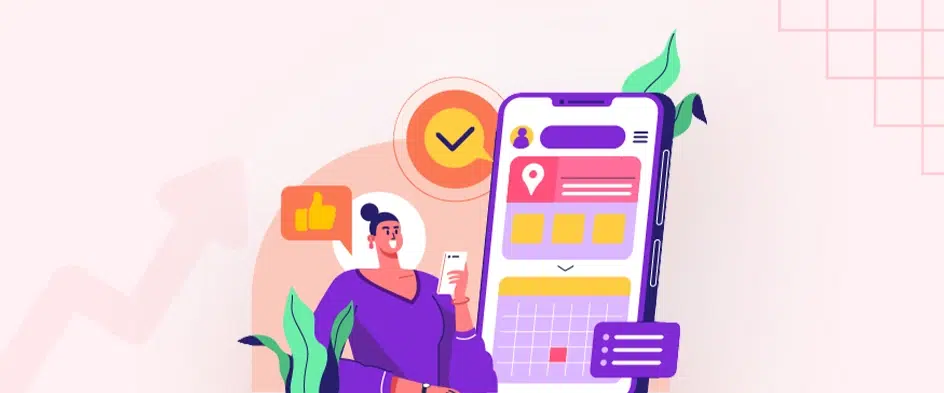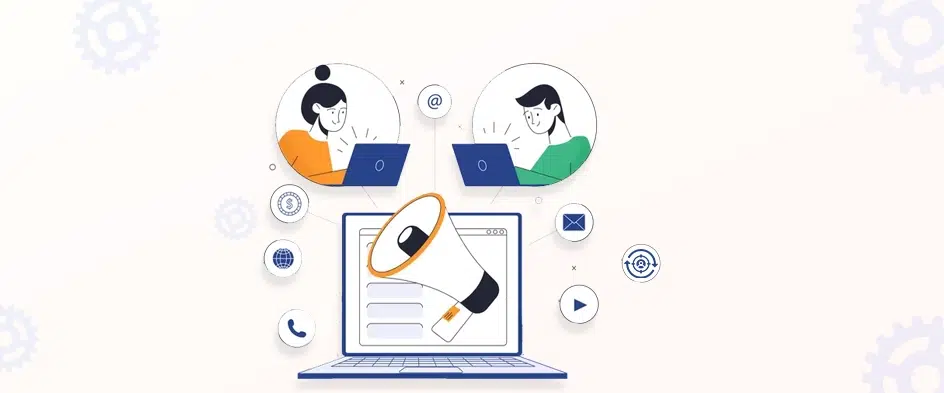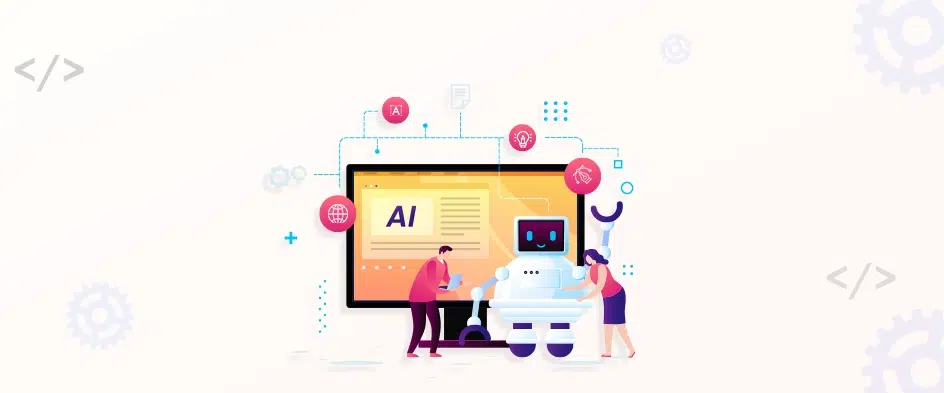How Much Does Android App Development Costs?

- 9 Minutes to read
Table of Content
- How is an Android App Developed?
- What are the Different Types of Android Apps?
- What are the Android App Development Costs?
- What Affects the Cost of Android App Development?
- What are the Additional Costs in Android App Development?
- How to Reduce the Android App Development Costs?
- Conclusion
- FAQs on Android App Development Costs
The world runs on applications, and Android, with its open-source nature, is a goldmine for app development. Plus, with millions of users worldwide, an Android app can be a powerful tool to connect, engage, and grow your audience.
But of course, with any kind of site or app development, cost is a significant factor for selecting the platform. Building an Android app can range from a reasonable investment to a significant expense.
So what would be the Android app development costs for your project? And how do the top mobile app development companies proceed with the project? Let’s find out.
How is an Android App Developed?
Android App Development involves the creation of applications specifically for devices running the Android OS. The development process involves utilizing the best tools and following the top trends in mobile app development. So the app’s functionality and user experience are top-notch.
Here’s the process for developing the best Android apps:
Step 1: Ideation and Planning
This initial phase focuses on brainstorming your app concept, defining its purpose and target audience. You’ll map out the features and functionalities, creating a blueprint for development.
Step 2: Design
Here, the visual identity of your app comes to life. User interface (UI) designers craft the screens and layouts, ensuring an intuitive and user-friendly experience.
Step 3: Development
This is where the coding magic happens. Developers write the code that brings your app’s functionalities to life, using the Android Studio development environment and programming languages like Java or Kotlin.
Step 4: Testing and Debugging
Meticulous testing is crucial to identify and fix any bugs or glitches. This ensures your app functions smoothly across different Android devices and versions.
Step 5: Deployment and Release
Once everything is polished, it’s time to launch your app! You’ll publish it on the Google Play Store, making it available for download by millions of users.
Step 6: Maintenance and Updates
The journey doesn’t end with release. Ongoing maintenance ensures your app stays up-to-date, fixing bugs, and adding new features. And you need to keep up with the evolving Android ecosystem.
There might be additional steps involved, like backend development, API integration, and security audits. But that depends on the complexity of your app. And that will decide the Android app development costs as well. And if you want continuous mobile app optimization, the costs will go higher.
You can choose a mobile app development company to get the best results with this process.
What are the Different Types of Android Apps?
Android apps can be broadly categorized into Native Apps, Hybrid Apps, and Web Apps. And each of them offers distinct development approaches and user experiences.
Native Apps
Native apps reign supreme in terms of performance and user experience. Built from the ground up using programming languages like Java or Kotlin, they seamlessly integrate with the Android operating system. This native environment grants them full access to device functionalities like the camera, GPS, and various sensors. That ensures a rich and responsive user experience.
Additionally, native apps typically provide a more intuitive feel as they are specifically designed for the intricacies of Android. For complex applications demanding top-tier performance and an unparalleled user experience, native development is the preferred approach. Examples of prominent native apps include powerhouses like Gmail, Instagram, and Facebook.
Hybrid Apps
Hybrid apps offer a strategic middle ground, combining elements of both native and web app development. Frameworks like React Native or Flutter empower developers to craft code once and deploy it across both Android and iOS platforms. This approach streamlines development time and reduces costs compared to building separate native apps for each operating system.
However, it’s important to acknowledge that hybrid apps might have limitations in accessing certain device features or may exhibit a slight lag in responsiveness when compared to their native counterparts.
Nevertheless, hybrid development presents a compelling solution for applications where cross-platform compatibility and faster time-to-market are crucial priorities. Many social media applications and news outlets leverage hybrid app development for their Android versions.
Web Apps
Web apps represent a distinct category, essentially functioning as mobile websites designed to provide an app-like experience. Accessed through a web browser, they eliminate the need for installation from the Google Play Store. That translates to a swift and user-friendly deployment process.
While web apps offer a level of accessibility, it’s essential to recognize that they might lack some functionalities inherent to native apps. Simpler applications, such as to-do lists or basic calculators, are often well-suited for development as web apps.
Understand the strengths and limitations of each category. So you can make an informed decision on the most suitable approach for your specific Android app development project.
What are the Android App Development Costs?
The average cost of Android app development varies based on the app’s complexity, features, and market requirements. So you need a cost-benefit analysis for investment decisions.
While it’s challenging to pinpoint an exact cost without understanding your specific app concept, here’s a general range to provide a starting point:
- Simple App: $15,000 – $40,000
- Medium Complexity App: $50,000 – $120,000
- Complex App: $250,000+
Remember, development isn’t the sole expense to consider. You need to factor in additional costs like app store listing fees, ongoing maintenance, and potential marketing expenses. That gives you a comprehensive picture of your app’s financial landscape. We’ll look at these factors later on.
If you want a better idea on these costs, I suggest you consult with the best Android app development companies.
What Affects the Cost of Android App Development?
Several factors influence the cost of Android app development, and understanding these factors can help you make informed decisions when budgeting for your project. Here’s a breakdown of the key considerations:
App Complexity
Simple apps with basic features are generally less expensive to develop than complex apps with extensive functionalities. The more intricate the features and functionalities, the more development time and resources required, translating to higher costs.
Development Team
The experience level and location of your development team significantly impact the cost. Hiring a team of seasoned developers with a proven track record will command a higher hourly rate compared to a team of junior developers. Additionally, geographical factors play a role, as developer rates can vary depending on the region.
App Features
The specific features you incorporate into your app directly influence the development time and cost. Features like social media logins, push notifications, or real-time chat functionalities require additional development effort compared to a basic app.
Design Complexity
A straightforward app design with minimal animations or custom UI elements will cost less to develop than a highly customized design with complex animations or 3D graphics. Elaborate design elements can be visually appealing but necessitate more design expertise and time, driving up development costs.
Development Approach
The type of app you choose to build (native, hybrid, or web) can also affect the cost. Native apps generally require more development time compared to hybrid apps, but may offer a superior user experience. Web apps, on the other hand, can be the most cost-effective option but might have limitations in functionality.
Consider these factors and outline your app’s requirements carefully. That gives a realistic understanding of the Android app development costs.
What are the Additional Costs in Android App Development?
In addition to the ones shown above, there are some additional, hidden costs in Android app development. Costs like app store fees, marketing expenses, and ongoing maintenance can lead to cost overruns and budget challenges.
App Store Fees
While Google Play Store offers a freemium model, there are a couple of scenarios where service fees might apply. The first is a one-time registration fee of $25 to publish your app. This fee covers the cost of processing your app listing and making it available on the Play Store.
The second scenario involves in-app purchases. The users can pay real money for virtual goods or services within your app. Google Play collects a service fee on these transactions, which can range from 15% to 30% depending on the specific product category.
Marketing and Advertising
Making your app discoverable in a vast marketplace like Google Play requires strategic marketing and advertising efforts. While not a direct cost associated with development, allocating a budget for marketing is crucial to get your app in front of potential users.
The cost can vary depending on the marketing channels you choose. Here are some popular options to consider:
- App Store Optimization (ASO): Optimize your app’s listing with relevant keywords and captivating descriptions to improve organic search visibility within the Google Play Store.
- Social Media Marketing: Leverage social media platforms to target your ideal audience and generate interest in your app. You can get the top social media marketing agencies to create engaging content and run targeted ads. And you can collaborate with social media influencers to spread the word.
- Search Engine Marketing (SEM): Utilize search engine marketing strategies to increase your app’s visibility in search engine results pages (SERPs). This can involve pay-per-click (PPC) advertising or organic search optimization techniques.
- Public Relations (PR): Secure positive media coverage for your app through press releases, media outreach, and influencer marketing campaigns.
- Content Marketing: Create valuable and informative content related to your app. It will help attract users and establish yourself as a thought leader in your industry.
The most effective marketing strategy will depend on your specific app, target audience, and budget. However, by implementing a well-rounded marketing plan, you can significantly increase your chances of success in the competitive Android app market.
Maintenance and Updates
Developing an app is an ongoing process. Maintenance and updates ensure your app functions smoothly, stays secure, and keeps pace with evolving technologies. This might involve:
- Bug fixes: Addressing any bugs or glitches that users encounter to maintain a positive user experience.
- New features: Implementing new features to enhance the app’s functionality and user experience based on user feedback and market trends.
- Security updates: Regularly patching security vulnerabilities to safeguard user data and address potential security exploits.
- Android version compatibility: Ensuring your app remains compatible with new versions of the Android operating system as they are released.
Maintenance costs typically range from 15% to 20% of the initial development cost per year. Factoring in maintenance expenses from the outset will help you budget more effectively for the entire lifecycle of your Android app.
How to Reduce the Android App Development Costs?
As I mentioned, the costs depend on the complexity, experience and expertise of the developers, development approach, and more. So the cost of development goes hand-in-hand with the quality of the application.
But still, there are a few ways to control and even (potentially) reduce the Android app development costs:
Define a Clear Scope
Before diving into development, meticulously plan and define the core functionalities of your app. Prioritize the essential features that deliver core value to your users. You can always introduce additional features later as your app evolves.
Develop an MVP (Minimum Viable Product)
Focus on creating a Minimum Viable Product (MVP) first. An MVP is a stripped-down version of your app that incorporates the most critical features. This allows you to validate your app concept with real users, gather valuable feedback, and refine your approach before investing heavily in a feature-rich version.
Prioritize Features
Not all features are created equal. Analyze which features are must-haves for launch and which ones can be added later. This prioritization helps you focus development efforts on the features that will have the most significant impact on user acquisition and engagement in the initial stages.
Consider Cross-platform Development
If your app doesn’t require extensive native functionalities, consider a cross-platform development approach using frameworks like React Native or Flutter. This approach allows you to build a single codebase that can be deployed on both Android and iOS platforms, potentially reducing development time and costs.
Open-source Tools and Templates
Leverage the power of open-source libraries, frameworks, and pre-built templates whenever possible. These readily available resources can streamline development, saving you time and money compared to building everything from scratch.
Outsource Strategically
Depending on your project needs and budget, outsourcing development tasks to a qualified team or freelancers can be a cost-effective option. Explore outsourcing options in regions with competitive developer rates, but ensure you prioritize quality and clear communication throughout the process.
Simple and User-friendly Design
A clean and intuitive user interface (UI) doesn’t necessitate complex animations or elaborate graphics. Opt for a user-centric design that prioritizes usability and functionality. This can streamline development and reduce design costs.
Code Reusability
Encourage developers to write modular and reusable code components whenever possible. This reduces redundancy and streamlines development, particularly when building upon the core functionalities in future updates.
Consult with the top Android app development companies to understand the minimum costs for your technical and non-technical requirements.
Conclusion
From this blog, you must have understood that Android app development costs are quite dynamic in nature. They depend on factors like complexity of your app, the development approach, and the ongoing maintenance needs. So there’s no clear way of estimating the real costs involved.
But if you’re worried about the costs, carefully plan your app’s functionalities, prioritize the essential features, and explore the best strategies. These tactics will help optimize the development process and ensure the app delivers an exceptional value for money.Want the best Android app, but worried about the costs? Then our recommendations on the best Android development companies are just what you need.
FAQs on Android App Development Costs
1. Is it possible to estimate the real cost of Android app development?
Yes. The best way is to consult with experienced Android app developers. They can analyze your app concept and understand your requirements. Then you get a more accurate estimate based on the specific functionalities and features you envision.
2. How do the features of an app affect its development cost?
The more complex and advanced features an app requires, the higher the development cost will be. Features like in-app purchases, push notifications, and third-party integrations can significantly increase the cost.
3. Does the design of an app impact its development cost?
Yes, a well-designed app with custom graphics and animations will require more time and resources, leading to a higher development cost. Pre-made templates or basic designs can help reduce the cost.



